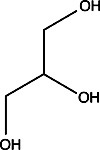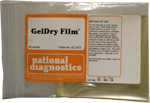Electrophoresis
AquaPor LE GTAC Agarose
$60.00 – $399.00
- Highest Quality Molecular Biology Grade Agarose
- Low Electroendosmosis
- DNase and RNase free
- Rapidly Dissolving, Low Boil-Over
Description
- Highest Quality Molecular Biology Grade Agarose
- Low Electroendosmosis
- DNase and RNase free
- Rapidly Dissolving, Low Boil-Over
AquaPor LE GTAC is the highest quality general purpose agarose gel available, ideal for most routine applications. Low EEO reduces the diffusion of smaller fragments and results in sharper, more clearly defined bands. High gel strength facilitates ease of use and handling of gels. Ultrafine particle size ensures the fastest and easiest dissolution. AquaPor LE is certified to contain no detectable DNase, RNase, or protease. It makes an excellent matrix for the resolution of nucleic acids as well as high molecular weight proteins. AquaPor LE may be used confidently for Southern, Northern, and Western blotting, as well as in-gel hybridizations.
| EEO (-mr) | Gel Strength (g/cm2) | Gel Temp (oC) |
| ≤ 0.12 | ≥ 1200 @ 1.0% | ≥ 37 @ 1.0% |
Additional information
| Weight | 0.3 lbs |
|---|---|
| Dimensions | 7 × 7 × 14 in |
Protocol
DISSOLVING AQUAPOR AGAROSES
- Add room temperature buffer to a flask that is 2.5 – 4 times the volume of gel solution. Add a teflon-coated stir bar.
- Add AquaPor powder while stirring vigorously so the agarose is dispersed uniformly. Stir for 2 minutes to hydrate the agarose.
- Tare the flask and solution.
- Place in a microwave oven and heat at 100% power using 20 – 60 second intervals. Swirl gently between intervals to resuspend the agarose.
- Continue the cycle of heating and swirling until the agarose is completely dissolved (no visible particles are present).
- Add distilled water to obtain the initial weight and mix.
- Cool the solution to 50 – 60°C before pouring the gel.
* Chill the gel for 30 minutes prior to comb removal when using AquaPor LM, HR, and low (<1%) concentration of AquaPor LE and ES.
Safety Overview
EMERGENCY OVERVIEW – IMMEDIATE HAZARD
WARNING! NEUROTOXIN. HARMFUL IF SWALLOWED, INHALED, OR ABSORBED THROUGH SKIN. MAY CAUSE ALLERGIC SKIN REACTION. MAY CAUSE EYE IRRITATION. POLYMERIZATION MAY OCCUR FROM EXCESSIVE HEAT OR CONTAMINATION. COMBUSTIBLE SOLID.
- UV Shadowing
- Using PAGE to Determine Nucleic Acid Molecular Weight
- Uneven Staining
- The Polyacrylamide Matrix-Buffer Strength
- The Polyacrylamide Matrix
- The Mechanical and Electrical Dynamics of Gel Electrophoresis — Electrophoresis System Dynamics
- The Mechanical and Electrical Dynamics of Gel Electrophoresis – Ohm’s Law
- The Mechanical and Electrical Dynamics of Gel Electrophoresis – Intro and Sample Mobility
- The Electrophoresis Matrix
- The Agarose Matrix
- Staining Proteins Immobilized on Membranes
- Staining Protein Gels with Coomassie Blue
- SSCP Analysis
- Southern Blotting
- Smeared Bands
- Silver Staining Protein Gels
- Silver Staining DNA Gels
- Sanger Sequencing
- Sample Preparation for SDS-PAGE
- Sample Preparation for Native Protein Electrophoresis
- Sample Preparation for Native PAGE of DNA
- Sample Prep for Denaturing PAGE of DNA
- S1 Mapping
- Run Conditions in Denaturing PAGE
- RNA Mapping
- RNA Electrophoresis
- Ribonuclease Protection
- Restriction Digest Mapping
- Radioactive Emissions and the Use of Isotopes in Research
- Protein Fixation on Gels
- Primer Extension
- Preparing Denaturing DNA & RNA Gels
- Preparation of Denaturing Agarose Gels
- Preparation of Agarose Gels
- Pouring Sequencing Gels
- Post-Electrophoretic Visualization with Nuclistain
- PFGE and FIGE
- Peptide Mapping
- PCR Analysis: Yield and Kinetics
- PCR Analysis: An Examination
- Overview of Western Blotting
- Northern Blotting
- Native Protein Electrophoresis
- Native PAGE of DNA
- Multiphasic Buffer Systems
- Mobility Shift Assay
- Methylation & Uracil Interference Assays
- Method for Western Blotting
- Mechanism of Immunostaining
- Mechanism of Immunostaining
- Measuring Molecular Weight with SDS-PAGE
- Maxam & Gilbert Sequencing
- Manual Sequencing
- Isotachophoresis
- Isoelectric Focusing
- In Gel Enzyme Reactions
- Immunostaining with Alkaline Phosphatase
- Immuno-Electrophoresis / Immuno-Diffusion
- Horizontal and Vertical Gel Systems – Vertical Tube Gels
- Horizontal and Vertical Gel Systems – The Vertical Slab Gel System
- Horizontal and Vertical Gel Systems – The Horizontal Gel System
- Homogeneous Buffer Systems
- Heteroduplex Analysis
- Guide Strip Technique
- Gel Preparation for Native Protein Electrophoresis
- Gel Preparation for Native PAGE of DNA
- Gel Electrophoresis of RNA & Post Electrophoretic Analysis
- Gel Electrophoresis of PCR Products
- Faint bands, low background
- Faint Bands, High Background
- Ethidium Bromide Staining
- Enzyme Linked Immunosorbent Assay (ELISA)
- Electrophoresis Buffers-Choosing the Right Buffer
- Electrophoresis Buffers–The Henderson-Hasselbalch Equation
- DNase I Footprinting
- DNA/RNA Purification from PAGE Gels
- DNA/RNA Purification from Agarose Gels – Electroelution
- Differential Display
- Denaturing Protein Electrophoresis: SDS-PAGE
- Denaturing Polyacrylamide Gel Electrophoresis of DNA & RNA
- Coomassie Blue Stain- Troubleshooting
- Conformational Analysis
- Casting Gradient Gels
- Buffer Additives-Surfactants
- Buffer Additives-Reducing Agents
- Buffer Additives-Hydrogen Bonding Agents
- Blotches on Gel
- Biological Macromolecules: Nucleic Acids
- Biological Macromolecules – Proteins
- Autoradiography
- Autoradiographic Enhancement with Autofluor
- Automated Sequencers
- Analysis of DNA/Protein Interactions
- An Overview of Northern and Southern Blotting
- Alkaline Blotting
- Agarose Gel Electrophoresis of DNA and RNA – Uses and Variations
- Agarose Gel Electrophoresis of DNA and RNA – An Introduction
- Activity Stains





